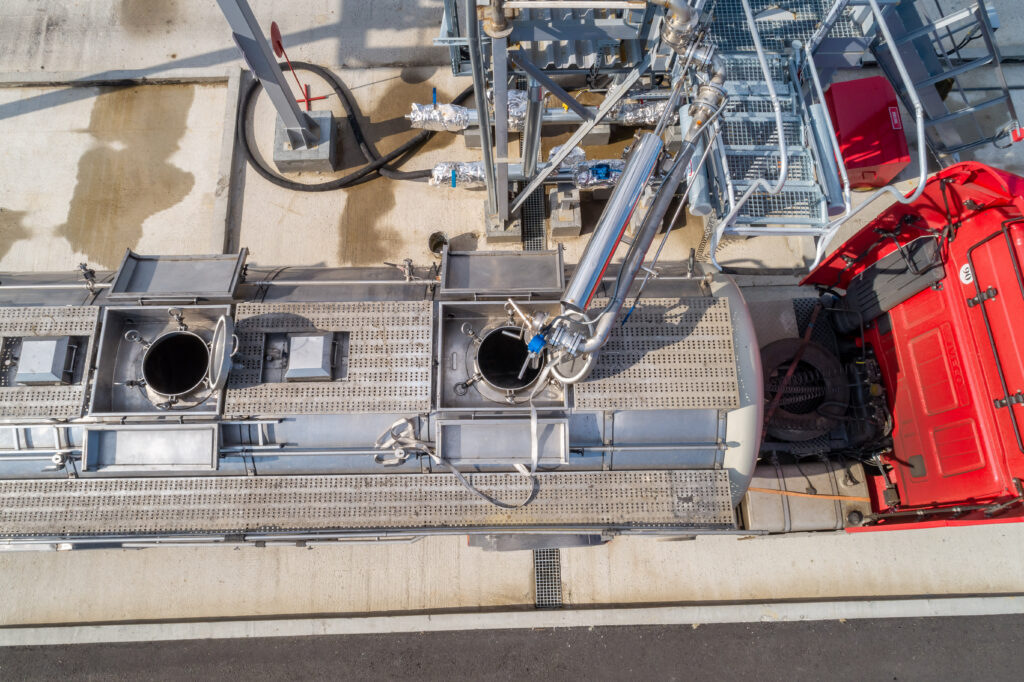Tanker Pull-Aways at Gangway Loading Platforms
7th February 2023

Industries such as oil & gas, food & beverage, chemical, and agriculture require goods to be transported by tankers. Commonly, these vehicles carry granular or liquid goods like fuel, flour, sugar, or plastics. These types of goods require specialized procedures to unload and load their goods.
When a tanker has reached its destination, it enters the unloading/loading area of a facility where hoses and or pumps are connected to the tank to unload or load the goods. It is common that tanker personnel will need to gain access to the top of the tank to allow for ventilation or attach hoses/pumps to begin the loading/unloading process. Many facilities have permanent or semi-permanent elevated loading platforms or gangway systems that allow authorized tanker personnel to safely access the top of the tanks.
Why is preventing pull-aways important?
While gangway platforms offer personnel ease of access, they also pose some risk. Property damage can occur when a tanker believes that the loading or unloading process is complete and begins to pull away from the loading site as its hoses/pumps are still connected. As a result, the gangway and other equipment could become damaged. Not only is equipment and property damaged when the tanker pulls away from the gangway, but personnel is also at risk of injury or even death. HSE lists fall from height the third highest cause of fatal injury, compromising 20% of fatal accidents. While most gangways or loading platforms use some type of fall protection such as guardrails, accidents still occur. In addition, it is common for tanker trucks to carry flammable or corrosive liquids which makes the safe loading/unloading of this material imperative for both the personnel and facility.
How to prevent gangway pull-aways:
Be proactive – The first step in preventing pull-aways at gangways systems is to be proactive. Don’t wait until a tanker has pulled away during the unloading/loading process and has caused equipment damage, product loss, or an injury before looking to prevent this type of occurrence.
Mitigate the risk – Mitigate the risk of a pull-away from occurring by installing the necessary equipment on the gangway system to prevent any accidents from occurring. Railings, communication systems, and interlocks are all examples of equipment that can greatly reduce risks.
Ensure clear communication – Communication is essential for a safe loading or unloading process to take place. Ensure tanker drivers and loading personnel can clearly and effectively communicate with each other throughout the entire process.
Force a Sequential Process – By forcing a step by step loading procedure, loading operations can be carried out safely without damage to personal or equipment. One way to force a sequential loading process to be followed is through an interlocking safety system. These systems can ensure that tankers cannot pull away from gangway loading structures while loading is taking place due to the forced sequential process these interlocks require.
While tankers are a critical part of many industries supply chains, they can pose some risks to facilities, equipment, and personnel during the loading/unloading process. Tankers can pull away from gangway loading platforms with hoses and pumps still attached potentially causing a dangerous situation. Pull-aways can be prevented by being proactive, mitigating the risk, ensuring clear communication between the tanker driver and loader, and forcing a sequential process to occur that eliminates the risk of a pull- away. Facilities that frequently use gangway loading platforms to unload or load tankers should take the necessary steps to ensure operations are safe, product loss is avoided, and equipment is protected.
Castell Safety International is part of the Sentric group, which consists of three sister companies – Kirk in the US, Castell in the UK and STI in France. Sentric group produces uncompromising safety solutions for businesses whose people and equipment operate in harsh and safety critical environments. From power generation and distribution, heavy plant works to loading bays and many industries in between, we believe that everyone has the right to be safe at work.

